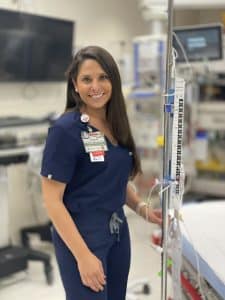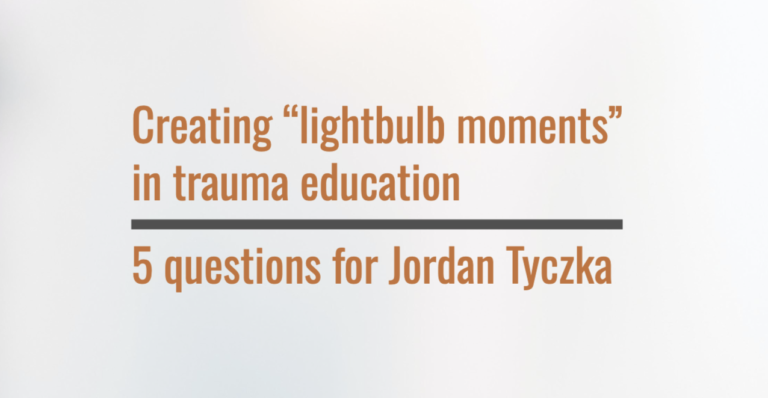Jordan Tyczka, MSN, RN, CEN, TCRN, has devoted much of her nursing career to trauma education.
From 2017 to 2023, Tyczka served as trauma services educator at Inova Loudoun Hospital, a Level III trauma center in Leesburg, Virginia. In this role, she helped nurses throughout the hospital provide more proficient trauma care and improve their interactions with both injured patients and their families.
Tyczka recently received the 2023 Distinguished TCRN Award from the Board of Certification for Emergency Nursing (BCEN) in recognition of her work as a trauma educator. In June, she was named Inova Loudoun’s new director of trauma services.
Trauma System News interviewed Tyczka by email to learn more about her approach to trauma nursing education.
What separates a successful trauma education program from one that struggles?
 In my experience, the more engaged your trauma team is, the stronger the program. You can have the most skilled trauma surgeons, a state-of-the-art trauma bay, every resource available and a great PI process. However, if you have a disengaged team, you will fall short. But when you have a trauma team in which everyone is striving for the same goal and working together — whatever your level of trauma center — you provide better care.
In my experience, the more engaged your trauma team is, the stronger the program. You can have the most skilled trauma surgeons, a state-of-the-art trauma bay, every resource available and a great PI process. However, if you have a disengaged team, you will fall short. But when you have a trauma team in which everyone is striving for the same goal and working together — whatever your level of trauma center — you provide better care.
I have found that one of the best ways to build trauma team engagement is to encourage nurses to work toward their certification. Here at Inova Loudoun Hospital, hundreds of nurses have set a personal goal of earning the Trauma Certified Registered Nurse (TCRN) certification. This has created palpable excitement surrounding our trauma program. Those nurses who are certified, or who are on their journey to certification, ask questions and seek out opportunities to learn more about trauma.
Are there any specific teaching techniques or learning formats that you recommend?
During the five years I served as the trauma services educator at Loudoun, I learned that nurses are all about the “hands on”. I think that’s why one of the most successful programs I developed was a trauma-themed escape room.
As many people know, an “escape room” is a game experience in which a group of people have to work together to follow clues and solve problems. Every year for our required annual education, I created a trauma escape room that included about 10 to 12 clues. Each clue led nurses to a problem or task, and nurses had to use their trauma nursing knowledge to complete each step. A clue might be:
- A crossword puzzle that tests the team’s knowledge of a trauma nursing topic
- A trifold display board with pictures of injuries and cards listing injury names, signs and symptoms, and treatments — the team needs to match the correct information cards to the correct pictures
- Hands-on patient scenario exercises — for example, quickly setting up Buck’s traction or an external ventricular drain. (As a trauma nurse, you never know what will happen next!)
The trauma escape room usually requires about 2 hours to complete. It takes a lot of brain power in the beginning, but nurses learn by doing and even more so when education is formatted as a game.
I love it when the escape room activity brings together a table of six nurses who are from different services that typically know very little about each other. By the end of the two hours, they are conversing very freely and comparing notes on trauma patients they have had on their units. It’s more than just an educational session, it’s an engagement session.
If you would like to develop your own trauma escape room, I recommend going to a real escape room event for some inspiration to get you started.
What are your strategies for incorporating trauma education into nurses’ busy daily schedules?
My favorite strategy is probably on-the-job education. It should be meaningful education, but quick — max 10 minutes. For example, I love “surprising” nurses on the unit with a rapid infuser they need to set up or a chest tube they have to prepare.
I like to build these mini-sessions into the working day for a few reasons. One, it prevents nurses from having to come in on a precious day off. (If they’re doing my escape room, they’re already doing that for me.) Two, it helps me build relationships with the nurses. If they have questions about a patient with a chest tube a week later, they know they can call me directly. And it just ensures that nurses know who I am when I come on the unit. Serving as the educator for a service line is very different than being a unit-based educator. When you have the opportunity for face time with bedside nurses, take it.
Another fun activity I like is the “action board” — a trifold white board with envelopes attached all over it. Each envelope contains several cards, and each card lists a random piece of equipment or task. A nurse picks a card from the action board and then has to set up the equipment or perform the task. For example, in the critical care areas the card might read “Set up the rapid infuser” or “Set up an art line”. In the acute care areas, it could be “Set up a chest tube” or “Perform a neuro assessment”. In my experience, nurses get excited when they see the board and simulation equipment coming to their unit.
What are your recommendations for engaging younger nurses in trauma education?
I recommend offering the Trauma Nurse Core Course (TNCC) to nurses during their orientation. It may seem like a lot, but TNCC is full of beneficial information about injury processes. A lot of young nurses are still in “school mode” and they absorb the lecture material like a sponge.
I also like to show new nurses how the flow works in the trauma bay — and that there is some actual method to this madness. I started my nursing career in a Level I trauma center. I remember watching my first trauma as a brand-new nurse and asking myself, “How did they know to do that”? It’s the trauma nursing process. I have had so many nurse residents express relief to know that the alphabet is there to help guide everyone in the room on what to do. It makes the resuscitation process much more relatable, and it makes new nurses feel that learning how to function in a resuscitation team is an attainable expertise.
Once new nurses have gone through TNCC, our trauma nurse specialists start to integrate them into our trauma team. The new nurse isn’t expected to be the primary nurse right away, but early integration allows them to see how the room works, how the team communicates with each other, how each person has a role, how patients respond to different injuries and so on.
Trauma nursing has come a long way, and making it more inclusive than exclusive will enable better mentoring for younger nurses.
What question do you wish someone would ask you about trauma education? (And what is your answer?)
The question I would like to be asked is, “As an educator, do you still feel impactful at the bedside?” My answer is a big YES.
However, I do have to say that the move from direct patient care to an education role was hard for me at first, because I loved being a bedside nurse. I worked in the emergency department for years before becoming an educator, and my very best days were when I could provide direct patient care. When I transitioned to nursing education, it was difficult.
What I learned is that as a trauma educator, you have to make your work about the patient. One way to do this is to participate at the bedside whenever possible. I think that being an active participant with our trauma patients has helped me develop much more meaningful education for nurses. For instance, because of my experiences I know exactly what barriers nurses have with external ventricular drain set-ups or the pitfalls that come with initiating massive transfusion.
In addition, don’t be afraid to teach a nurse at the bedside, just do so in a professional manner. (I never let a patient think that his or her nurses didn’t already know something I’m going over with them.)
Teaching at the bedside is so rewarding, because watching a nurse have their “lightbulb moment” in real time is the best.

